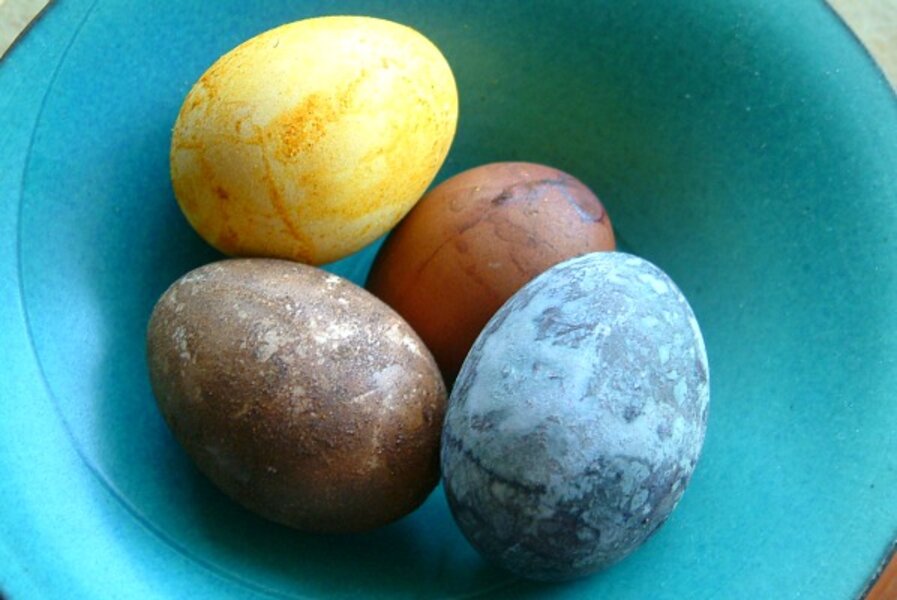Celebrate Earth Day with natural Easter egg dyes
Loading...
My organic brown eggs come with a newsletter. The Country Hen is out in Hubbardston, Mass., and although I’ve never been there the notes folded on top of my eggs nestled in their carton make me feel somehow connected to a flock of chickens wandering around their barns, sniffing fresh air from sun porches.
The most recent newsletter asked, “Why should the white eggs have all the Easter fun?”
Yes, why indeed? I decided my brown eggs needed some fun for the holiday, too.
The Country Hen newsletter shared a few ideas for natural food dyes and the more I looked around online I saw some really pretty natural dye Easter eggs that almost look like the stones you might find washed up on the shores of Lake Michigan or the rocky coast of Maine.
Eggs are widely used as a symbol for new beginnings, whether the uses have particular religious affiliations or not. Today also happens to be Earth Day, and while this day has heavy environmental and political issues associated with it, I like to think of it as a reminder to appreciate the beauty in the natural world around us. Rachel Carson is my champion for articulating this the best in her book, “The Sense of Wonder.”
I think she would have approved of the marriage of kitchen cupboard contents and humble brown eggs as a way to celebrate our planetary home and the perpetual promise of a fresh start. Natural egg dyeing is a much more laborious process than simply buying chemical dye kits from the drugstore. But the creativity unleashed while coming up with your own colors is worth the extra effort.
I found some ingredients on hand that I thought might yield interesting colors: 1/2 cup frozen blueberries, tumeric, paprika, Red zinger tea.
Here are some other suggestions:
Blue: red cabbage leaves, berries
Red/pink: Red zinger tea, beets, paprika, red onion skins
Yellow/orange: Saffron, tumeric, yellow onion skins, carrots
Green: spinach
Brown: coffee
Natural egg dyes formulas/recipes seem to be widely different, but since this is a bit of a science experiment I think anything goes. Don’t be afraid to tinker.
For every cup of water, I added 2 tablespoons of ingredients and 2 tablespoons of vinegar (most recipes call for white vinegar, but all I had on hand was cider vinegar and it worked fine).
Hard boiled eggs
Submerge eggs in water, enough for 1 inch of water above the eggs
Bring to a boil
Remove from heat and cover for 18 minutes
Rinse under cold water
Cool completely
Natural Easter egg dye
1 cup water
2 tablespoons of chosen ingredients
2 tablespoons vinegar
Bring water and dye ingredients to a boil. If you are using leafy ingredients or berries, boil until a good strong color releases into the water. Strain liquid (if you leave some pulp in the liquid it will give texture to your finished glaze). Add 2 tablespoons vinegar. Submerge hard boiled eggs in heated dye mixture and simmer for 1/2 an hour. For a richer color, pour hot liquid into ceramic mugs. Submerge 1 egg per cup. Soak for 1 hour or until desired shade is reached. Dry dyed eggs in empty egg carton.
For a polished looked, wait until eggs have dried completely and rub with a little bit of cooking oil.
Happy Earth Day!
Kendra Nordin blogs at Kitchen Report.
To comment on the original post, click here.
--------------------------------------------------------------
The Christian Science Monitor has assembled a diverse group of food bloggers. Our guest bloggers are not employed or directed by The Monitor and the views expressed are the bloggers' own and they are responsible for the content of their blogs and their recipes. All readers are free to make ingredient substitutions to satisfy their dietary preferences, including not using wine (or substituting cooking wine) when a recipe calls for it. To contact us about a blogger, click here.





